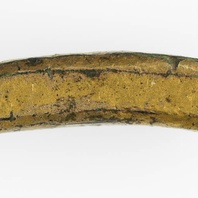
Viking Objects
Forged Hack-gold Rod (CM 595-2010)
This forged hack-gold rod comprises a curved section of gilt copper-alloy. It is square in cross-section and is broken at both ends. It shows that someone near Torksey was trying to con others by passing copper-alloy as gold. Like hacksilver, hack-gold was used to pay for items by weight of precious metal. The buyer and seller would agree the value of an item and pieces of silver or gold would have been cut up and weight out until the right amount had been paid. Gold was much less common among the Vikings than silver.
Read More
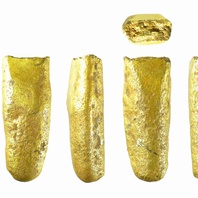
Viking Objects
Gold Ingot (BH-720251)
The Vikings arriving in England had a bullion economy in which they paid for goods, most commonly, with silver that was weighed to an amount agreed between the buyer and the seller. Though rarer than silver equivalents, this gold ingot formed part of the bullion currency used by Vikings in England. It took some time for the Scandinavian settlers to adopt a monetary economy like that of the Anglo-Saxons, and both systems were used simultaneously for a while before they fully adopted the new system. The Vikings were familiar with monetary economies but they treated coins as just another form of bullion before adoption of a monetary economy.
Read More
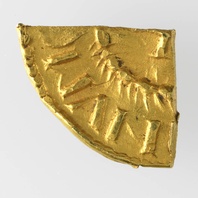
Viking Objects
Imitation Carolingian Gold Solidus (CM.521-1998)
This cut-quarter of an imitation gold solidus is one of 80 known imitations as opposed to 15 official solidi and is a copy of coins issued by Louis the Pious (778-840 CE). It was probably made somewhere in Frisia on the north-west coast of what is now the Netherlands. The importance of this carefully divided quarter-coin is as evidence for the acceptance of solidi on its actual monetary value rather than as mere bullion in the 9th century; if it were hack-gold it would not have been cut so meticulously. The Vikings would have obtained real and imitation Carolingian coins through their raiding and trading activities in the Frankish Empire.
Read More
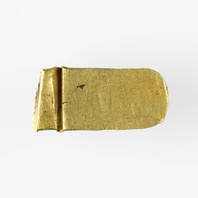
Viking Objects
Hack-gold (CM.1800-2008)
This rounded ingot terminal was cut from a larger rectangular ingot. Though rarer than hacksilver, this gold ingot formed part of the bullion currency used by Vikings in England and may be associated with their winter camp in Torksey.
Read More
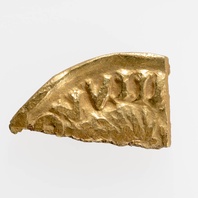
Viking Objects
Quartered Carolingian Gold Solidus (CM.163-2010)
This gold solidus of the Carolingian emperor, Louis the Pious (778-840 CE), was cut into pieces as hack-gold. Unlike the imitation gold solidus from the same era, it has not been cut carefully into quarters. Instead it has been snipped to the right size for weighing. Gold coins were used in the Carolingian empire until it adopted a silver standard.
